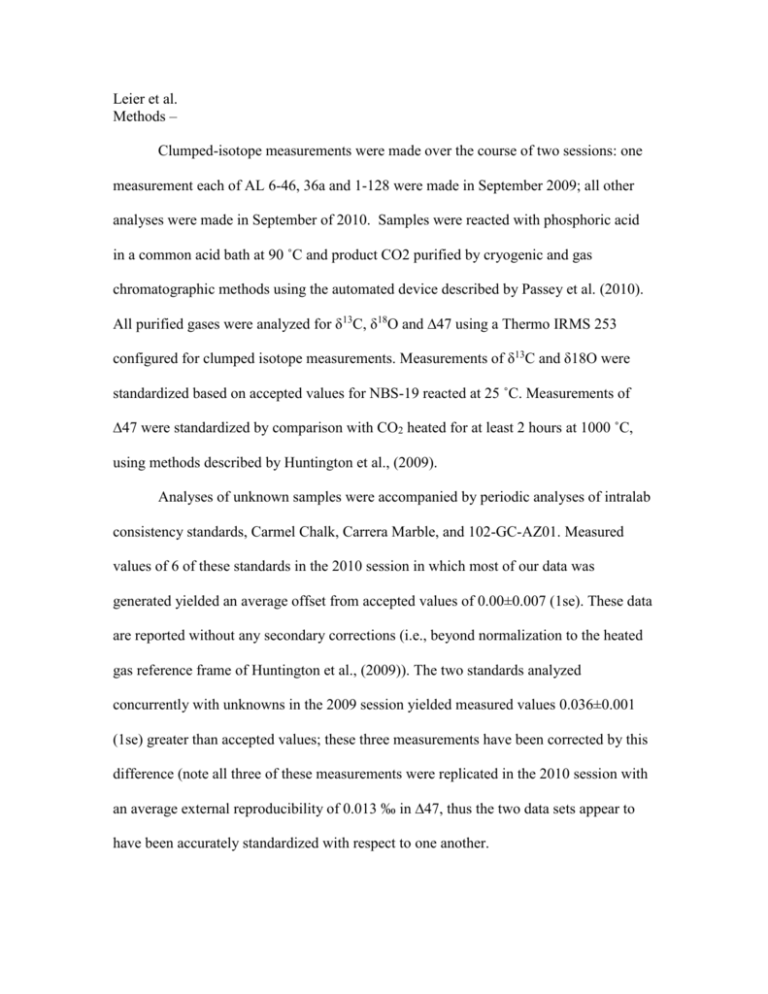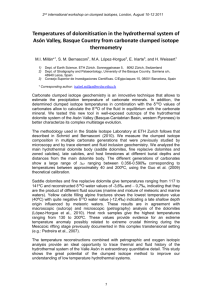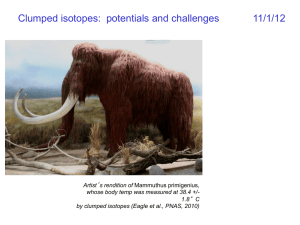Stable isotope evidence for multiple pulses of rapid surface uplift in
advertisement

Leier et al. Methods – Clumped-isotope measurements were made over the course of two sessions: one measurement each of AL 6-46, 36a and 1-128 were made in September 2009; all other analyses were made in September of 2010. Samples were reacted with phosphoric acid in a common acid bath at 90 ˚C and product CO2 purified by cryogenic and gas chromatographic methods using the automated device described by Passey et al. (2010). All purified gases were analyzed for δ13C, δ18O and ∆47 using a Thermo IRMS 253 configured for clumped isotope measurements. Measurements of δ13C and δ18O were standardized based on accepted values for NBS-19 reacted at 25 ˚C. Measurements of ∆47 were standardized by comparison with CO2 heated for at least 2 hours at 1000 ˚C, using methods described by Huntington et al., (2009). Analyses of unknown samples were accompanied by periodic analyses of intralab consistency standards, Carmel Chalk, Carrera Marble, and 102-GC-AZ01. Measured values of 6 of these standards in the 2010 session in which most of our data was generated yielded an average offset from accepted values of 0.00±0.007 (1se). These data are reported without any secondary corrections (i.e., beyond normalization to the heated gas reference frame of Huntington et al., (2009)). The two standards analyzed concurrently with unknowns in the 2009 session yielded measured values 0.036±0.001 (1se) greater than accepted values; these three measurements have been corrected by this difference (note all three of these measurements were replicated in the 2010 session with an average external reproducibility of 0.013 ‰ in ∆47, thus the two data sets appear to have been accurately standardized with respect to one another. The average standard error of each analysis based on mass spectrometric reproducibility alone was ±0.010 (1se). All samples were analyzed in duplicate or (in the case of those analyzed in both 2009 and 2010) triplicate, with average reproducibility of ±0.011 (1sd) and average external error of ±0.007 (1se). These average errors are generally consistent with expected counting statistics limits and suggest no significant additional experimental errors. The average standard error for the average of each unknown sample is equivalent to a temperature error of approximately ±1.6 ˚ (though varying slightly with absolute temperatures). The measurements reported in this study were conducted prior to the creation of the absolute reference frame of Dennis et al. (2011) and so we report them relative to the Caltech intralab reference frame described in Huntington et al. (2009) (which is consistent with the initial calibration data of Ghosh et al. (2006) and other calibrations published prior to 2011). We convert ∆47 values into equivalent temperatures using the function given by Ghosh et al. (2006). At the time this paper is published there exists some uncertainty regarding the consistency of this calibration across different laboratories, materials and methods of acid digestion. However, those uncertainties are generally similar to nominal analytical errors in the temperature range recorded by our samples, and these discrepancies appear to arise principally from differences in methods and materials used in separate laboratories; thus we believe the best practice at present is to use calibrations based on measurements in the Caltech lab. For convenience, we also present equivalent values of ∆47 in the absolute reference frame, based on the transfer function: ∆absolute = ∆CIT x 1.0369 + 0.027. These should be regarded as approximate, as they are based on accepted values for these standards as measured in the Caltech intralab reference frame of Huntington et al., rather than on direct calibration of the absolute reference frame during the sessions in question. Nevertheless, they provide a reasonable estimate of expected values for any future attempts to reproduce the data we present or to compare our data with independently generated data sets. Dennis, KJ, Affek HP, Passey BH, Schrag DP, and Eiler JM, 2011, Defining an absolute reference frame for ‘clumped’ isotope studies of CO2: Geochimica et Cosmochimica Acta, 75, 7117-7131. Ghosh, P., Adkins, J., Affek, H., Balta, B., Guo, W.F., Schauble, E.A., Schrag, D., Eller, J.M., 2006. C-13-O-18 bonds in carbonate minerals: A new kind of paleothermometer. Geochimica Et Cosmochimica Acta 70, 1439-1456. Huntington, K.W., Eiler, J.M., Affek, H.P., Guo, W., Bonifacie, M., Yeung, L.Y., Thiagarajan, N., Passey, B., Tripati, A., Daëron, M., Came, R., 2009. Methods and limitations of ‘clumped’ CO2 isotope (Δ47) analysis by gas-source isotope ratio mass spectrometry. Journal of Mass Spectrometry 44, 1318-1329. Passey, B.H., Levin, N.E., Cerling, T.E., Brown, F.H., and Eiler, J.M., 2010, Hightemperature environments of human evolution in East Africa based on bond ordering in paleosol carbonates: Proceedings of the National Academy of Sciences, 107, 11245-11249.











